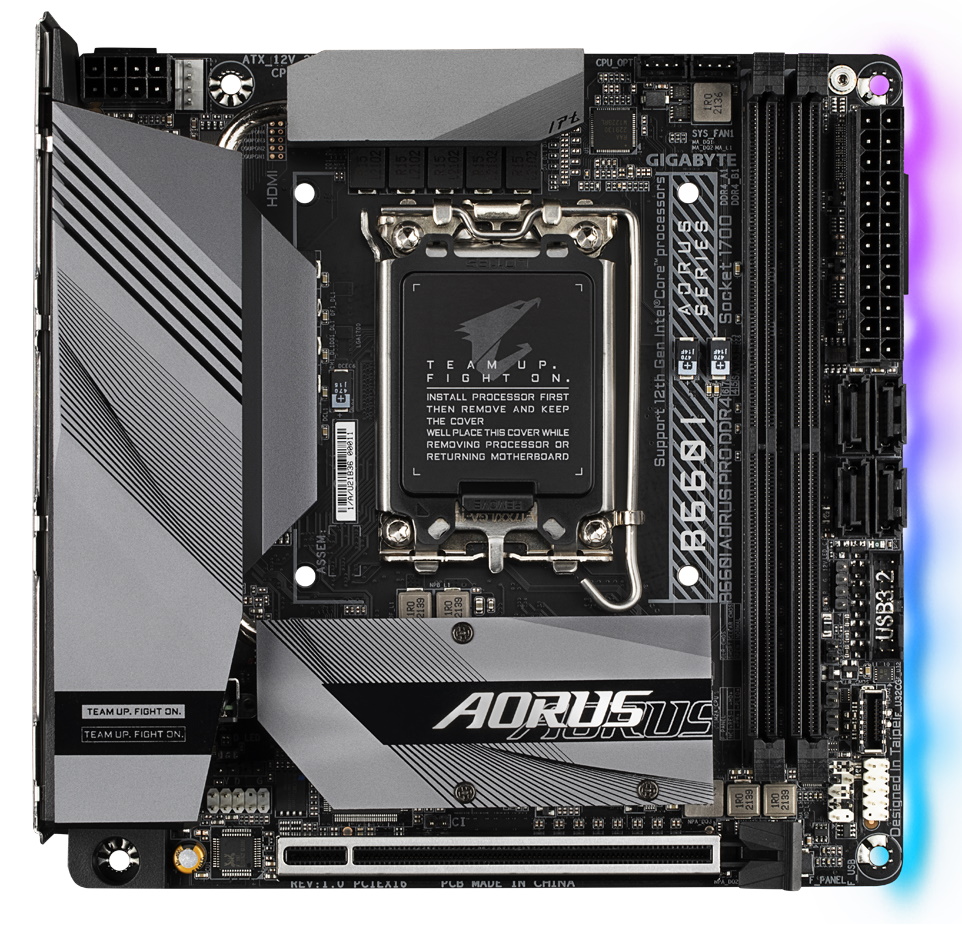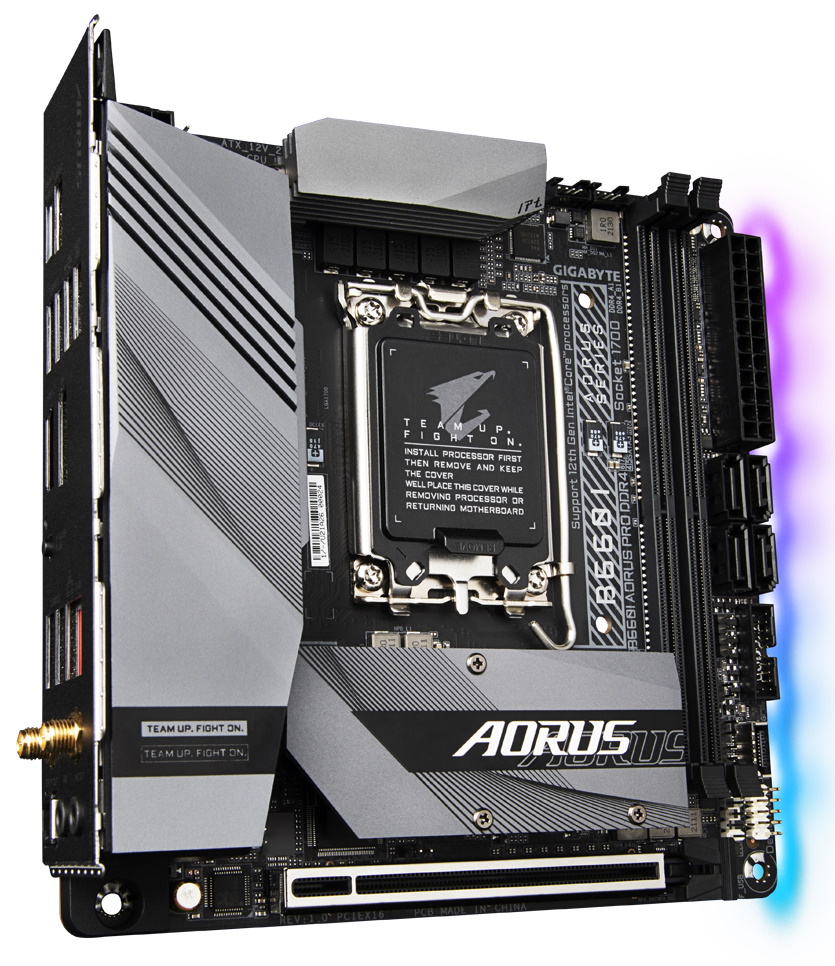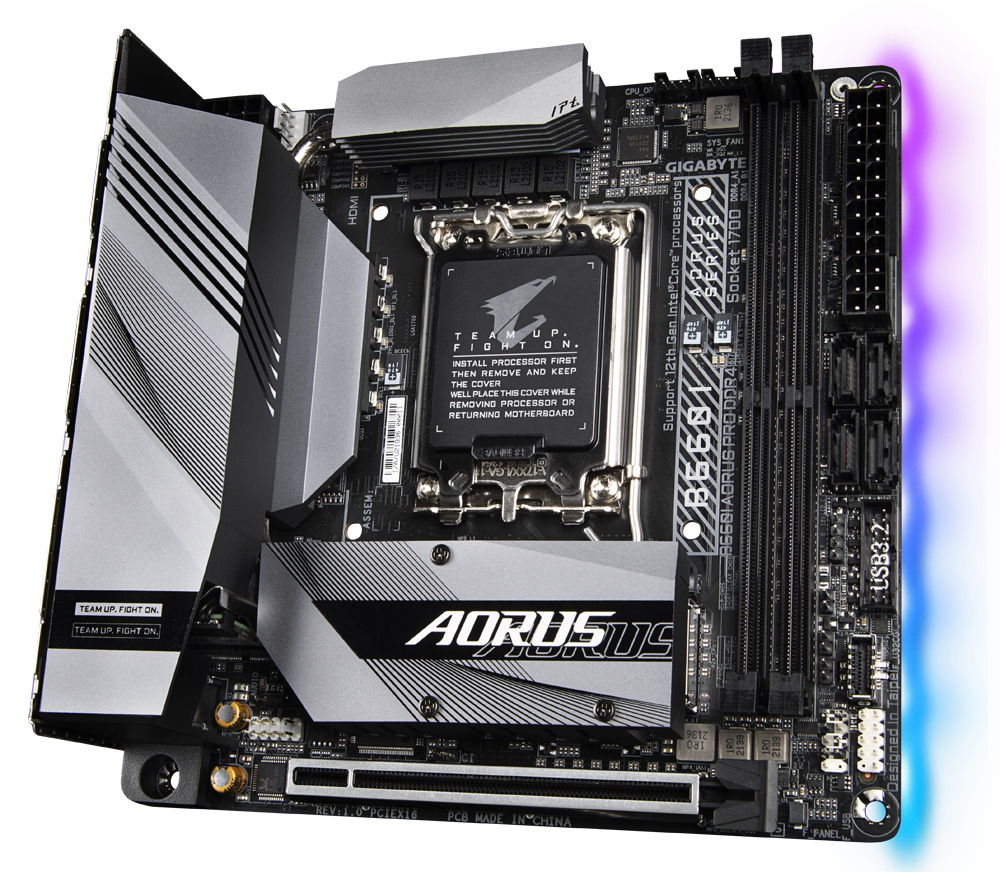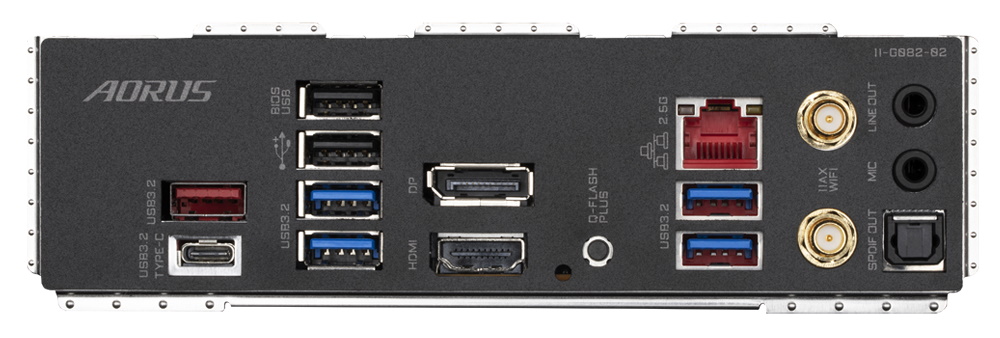Tom's Hardware Verdict
Priced around $245, the B660I Aorus Pro DDR4 is the most expensive B660 Mini ITX motherboard. Although it covers the basics, looks good and has overbuilt VRMs, competing boards cost less and are better equipped.
Pros
- +
Robust 90A VRMs
- +
Premium appearance, including RGB LEDs
Cons
- -
Highest priced B660 ITX board
- -
Only one M.2 socket
- -
Dated, mid-range audio codec
- -
No Gen 2x2 (20 Gbps) USB ports
Why you can trust Tom's Hardware
Gigabyte’s B660I Aorus Pro DDR4 aims to be the ITX solution of choice for those looking for a compact B660-chipset baord. But priced at $245.99 as of this writing, it’s the most expensive B660 Mini ITX motherboard available. It’s arguably the best-looking board of the bunch, and it has integrated RGBs, which its competitors lack. But looks and lights aside, Asus’ ROG Strix B660-I Gaming WIFI checks off a few more boxes and costs less.
The B660I Aorus Pro DDR4 implements a surprisingly robust VRM, with 90A MOSFETs, along with four SATA ports, a single M.2 socket, 2.5 GbE and integrated Wi-Fi 6. In all, it’s a competent and complete Mini ITX motherboard, but an expensive one that emphasizes aesthetics over more substantive features.
On the performance side, the B660I Aorus Pro DDR4 did well overall, but had some struggles in certain tests. It did well in our Procyon Office testing, but the Photo and Video Editing tests were on the slower side of average, along with the x264 part of Handbrake. Outside of that, performance was average among its DDR4-based peers, including gaming and memory bandwidth tests. Overall, you’d be hard-pressed to find a difference in most tests without looking at the benchmarks.
We’ll dive into the board’s full feature set and performance below. Spoilers though: As you might have guessed if you’ve read this far, this board doesn’t earn a spot on our best motherboards. But before we delve into the full details of the B660I Aorus Pro DDR4, here’s a list of its specs, direct from Aorus.
Specifications: Gigabyte B660I Aorus Pro DDR4
| Socket | LGA1700 |
| Chipset | B660 |
| Form Factor | ITX |
| Voltage Regulator | 10 Phase (8+1+1, 90A SPS MOSFETs for Vcore) |
| Video Ports | (1) HDMI (v2.0) |
| Row 5 - Cell 0 | (1) DisplayPort (v1.4) |
| USB Ports | (1) USB 3.2 Gen 2 Type-C (10 Gbps) |
| Row 7 - Cell 0 | (1) USB 3.2 Gen 2 Type-C (10 Gbps) |
| Row 8 - Cell 0 | (4) USB 3.2 Gen 1 (5 Gbps) |
| Row 9 - Cell 0 | (2) USB 2.0 (480 Mbps) |
| Network Jacks | (1) 2.5 GbE |
| Audio Jacks | (2) Analog + SPDIF |
| Legacy Ports/Jacks | ✗ |
| Other Ports/Jack | ✗ |
| PCIe x16 | (1) v4.0 (x16) |
| PCIe x8 | ✗ |
| PCIe x4 | ✗ |
| PCIe x1 | ✗ |
| CrossFire/SLI | ✗ |
| DIMM Slots | (2) DDR5 6200+(OC), 64GB Capacity |
| M.2 Sockets | (1) PCIe 4.0 x4 (64 Gbps) / PCIe (up to 80mm) |
| U.2 Ports | ✗ |
| SATA Ports | (4) SATA3 6 Gbps (Supports RAID 0/1/5/10) |
| USB Headers | (1) USB v3.2 Gen 1, Type-C (5 Gbps) |
| Row 24 - Cell 0 | (1) USB v3.2 Gen 1 (5 Gbps) |
| Row 25 - Cell 0 | (1) USB v2.0 (480 Mbps) |
| Fan/Pump Headers | (3) 4-Pin (CPU, Watercooling CPU, System Fan) |
| RGB Headers | (1) aRGB (3-pin) |
| Row 28 - Cell 0 | (1) AURA RGB (4-pin) |
| Diagnostics Panel | ✗ |
| Internal Button/Switch | ✗ |
| SATA Controllers | ✗ |
| Ethernet Controller(s) | Intel I225-V (2.5 Gbps) |
| Wi-Fi / Bluetooth | Intel AX201 Wi-Fi 6 (2x2 ax, MU-MIMO, 2.4/5/6 GHz, 160 MHz, BT 5.2) |
| USB Controllers | Via Labs VL817-Q7 |
| HD Audio Codec | Realtek ALC897 |
| DDL/DTS | ✗ / ✗ |
| Warranty | 3 Years |
Inside the Box of the Gigabyte B660I Aorus Pro DDR4
Gigabyte includes a few accessories along with the board. You get the Wi-fi Antenna, an RGB extension cable, SATA cables, and more. My review sample didn’t come with a driver disk/USB stick. If yours arrives the same way, get the drivers from the website. Below is the full list of included accessories.
- (2) SATA 6Gb/s cables
- (2) 4-pin to 4-pin fan adapters
- RGB extension cable
- Wi-Fi antennas
- M.2 SSD screw packages
- User manual
Design of the B660I Aorus Pro DDR4





After removing the tiny board from the box, we get a closer look at some of the design elements. The B660I Aorus Pro has a 10-layer black PCB with a matte finish. The VRMs, chipset and M.2 socket get cooled by three heatsinks connected by a heat pipe. Like many Aorus Z690/B660 motherboards, the heatsinks are all a contrasting gray color, along with some design elements and the Aorus branding on the M.2 portion of the heatsink. Below the right edge are several RGB LEDs that produce a bright glow. Overall, this is a good-looking board and the only one in this class with RGBs.
With larger boards, we split the feature discussion into halves, but since there isn’t a distinct top and bottom here, we’ll cover the features moving clockwise around the board. The left VRM heatsink is as tall as the rear IO plate, which covers most of the left side. On top is a required 8-pin EPS to power the CPU, while next to it is one (of three) fan headers.
Get Tom's Hardware's best news and in-depth reviews, straight to your inbox.
Moving right, past the top VRM bank, are two more 4-pin fan headers. However, these are smaller to save space and require the included 4-pin to 4-pin adapters to fit standard fan connectors. Each header supports PWM and DC fans, with output up to 2A/24W.

The VRMs are, by far, the most robust we’ve seen on a B660 ITX board. While not the most by phase count, Gigabyte used 90A SPS MOSFETs on this board, just like the Z690I Aorus Ultra Plus. Some will look at this as a good thing, and in some ways it is. However, using overkill power parts on a platform that doesn’t support overclocking the processor just drives up the price. So, kudos to Gigabyte, but this is likely the main reason why competing boards cost less. That said, power comes from the 8-pin EPS connector to a Renesas RAA229130 controller and onto eight 90A Intersil ISL99390 SPS MOSFETs. The 720A available is plenty to power our Intel Core i9-12900K.
We spy two unreinforced DRAM slots to the right, with latching mechanisms on both sides. Gigabyte lists support for 64GB at speeds up to DDR4 5333(OC). The board ran both kits (DDR4-3600, DDR4-4000) without issue. Just be careful not to slip off the bottom locking mechanism. I did that, and the front panel headers punctured my finger.
Along the right edge, working our way down, we run into the 24-pin ATX connector to power the board, plus four SATA ports (supporting RAID0/1/5/10 with sharing). Below this are two USB headers, a Gen 2 (10 Gbps) Type-C and Gen 1 (5 Gbps) Type-A. Disappointingly, this board does not have a 20 Gbps port as its lower-prieced competitors do. Also in this area is a 4-pin RGB header for additional RGB lighting. Below that is the front panel header, along with a USB 2.0 header.
Along the bottom edge is the full-length reinforced PCIe 4.0 x16 slot. The audio codec (Realtek ALC897) and a couple of Chemicon brand audio caps are to the left. The audio section here is dated, but most should find it adequate. Also in this area is the front panel audio header (white) along with the 3-pin ARGB header.

The rear IO area sports a pre-installed IO plate matching the Aorus theme (black and gray). The black background gives way to Aorus branding and labels for the ports in a dark gray. While it’s nice these are labeled, the dark gray doesn’t contrast as much as white, so the legends are difficult to read, especially in low-light situations.
In total, there are eight USB ports: One USB 3.2 Gen 2 (10 Gbps) Type-C, one USB 3.2 Gen 2 (10 Gbps), four USB 3.2 Gen 1 (5 Gbps) ports, and two USB 2.0 (480 Mbps) ports. Seven Type-A ports should be enough for most users–especially those building a compact PC. Video outputs for the iGPU consist of one HDMI and one DisplayPort. You’ll also find the Intel-based 2.5 GbE port and the Wi-Fi 6 antenna connections here. To access the Q-Flash functionality (BIOS flashing without a CPU), there’s a tiny button between the video outputs and USB ports. Last here is the audio stack, consisting of two analog plugs and an optical SPDIF port.
MORE: Best Motherboards
MORE: How To Choose A Motherboard
MORE: All Motherboard Content
MORE: Best Motherboards
MORE: How To Choose A Motherboard
MORE: All Motherboard Content
MORE: Best Motherboards
MORE: How To Choose A Motherboard
MORE: All Motherboard Content

Joe Shields is a staff writer at Tom’s Hardware. He reviews motherboards and PC components.
-
shady28 Good to see you guys doing more mATX and ITX board reviews.Reply
One suggestion on motherboard reviews. Test the M.2 performance and one of the higher speed USB 3.2 ports.
I've noticed on other sites, some motherboards can have much slower real world performance on the M.2 and USB ports than otherwise identically setup boards with the same chipset.
I believe this is why some of your boards are showing up under performing on the compression tests. The differences in this area can be significant. Example below.